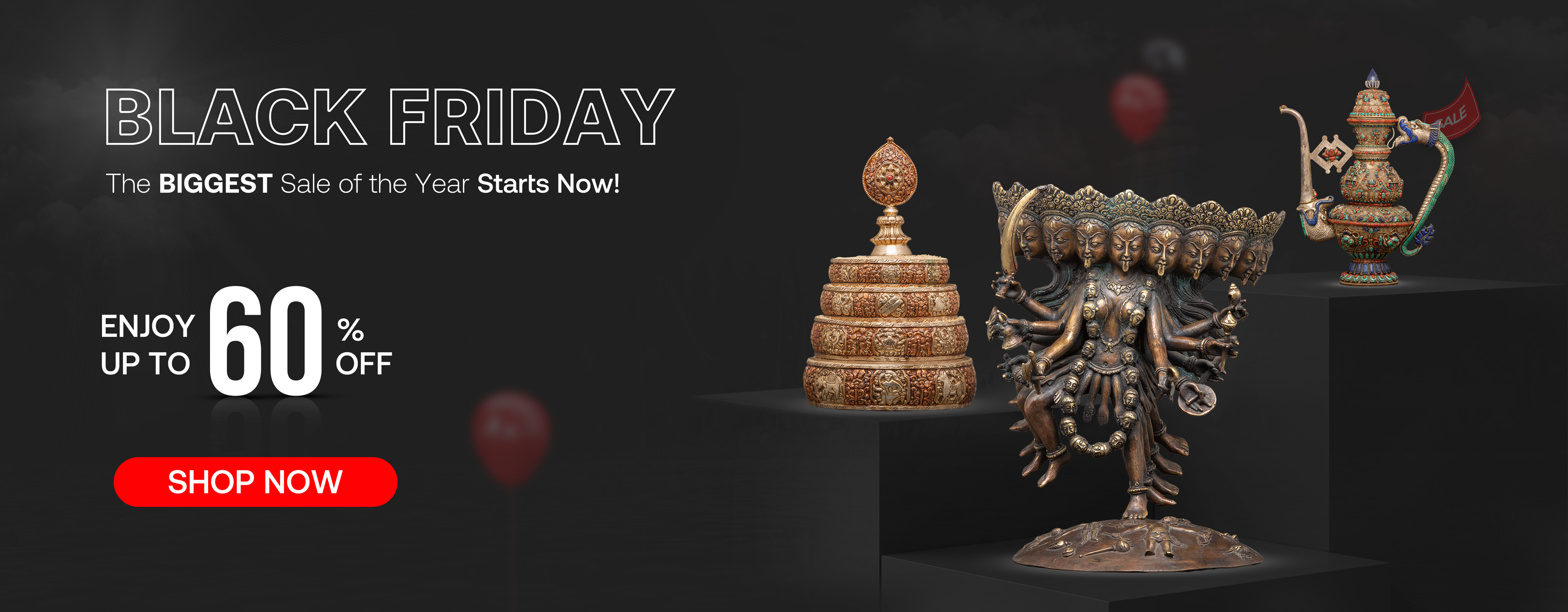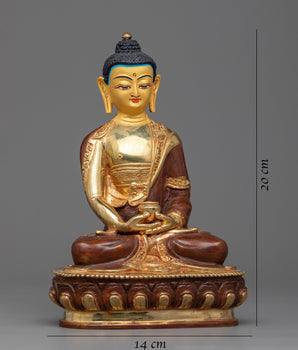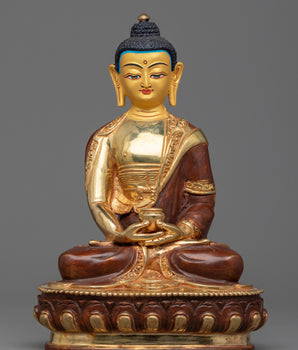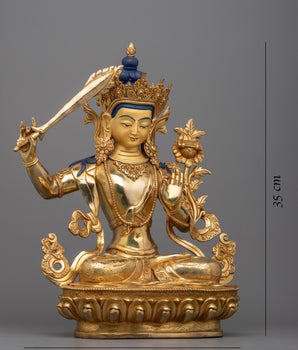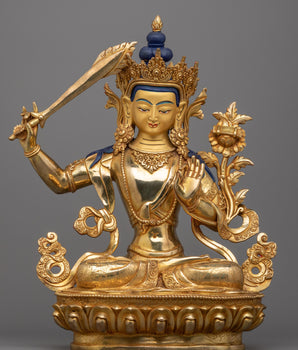Explaining the Mystic Persona
Maheshvara, also known as Lhachen Wangchug in Tibetan Buddhism, manifests the union of Hindu and Buddhist spiritual traditions. Shiva in Hinduism embodies destruction and renewal, ensuring the cosmic cycle’s continuity. Tibetan Buddhism reinterprets Maheshvara through the lens of Vajrayana teachings, particularly in texts like the Chakrasamvara Tantra, which narrates his transformation from a wrathful deity to a guardian of wisdom and compassion. His symbolic attributes—such as the trident and crescent moon—represent mastery over dualities. Maheshvara’s legacy is immortalized in Himalayan art, literature, and sacred geography, particularly Mount Kailash, regarded as his divine abode. This fusion of myth and philosophy highlights his role as a bridge between traditions and resonates with seekers across cultures. Through art and storytelling, Maheshvara remains a profound symbol of transcendence and spiritual harmony.
The Origin of Maheshvara in Hinduism

Click Here To View Our high-quality statue of Shankar Mahadeva
Maheshvara, identified with Shiva, is a cornerstone of Hindu cosmology. As part of the Trimurti, he fulfills the role of the destroyer, complementing Brahma the creator and Vishnu the preserver. Rooted in the Vedic tradition, Shiva emerged as Rudra, a fierce deity in the Rigveda, evolving into the all-encompassing Maheshvara in later texts like the Puranas and Upanishads. Depicted meditating on Mount Kailash or as the cosmic dancer Nataraja, Shiva embodies destruction as a precursor to renewal. His myths, such as the churning of the ocean (Samudra Manthan), highlight his transformative power and his role in maintaining cosmic balance.
Maheshvara, synonymous with Shiva, is deeply embedded in Hindu mythology, reflecting themes of destruction, regeneration, and cosmic balance. Emerging as Rudra in the Rigveda, he was initially worshiped as a storm deity associated with ferocity and healing. Over time, his persona evolved, becoming Shiva in later epics like the Mahabharata and Puranas.
The Shiva Purana depicts Maheshvara as the cosmic dancer Nataraja, symbolizing the rhythm of creation and destruction. Myths like the Samudra Manthan recount his unparalleled selflessness when he drank poison to save the universe. Shiva’s multi-faceted nature—from ascetic meditating on Mount Kailash to the fierce destroyer of ignorance—reinforces his transcendence beyond conventional dualities.
Maheshvara in Tibetan Buddhism
In Tibetan Buddhism, Maheshvara, or Lhachen Wangchug, is both a symbol of transformation and a link between Hindu and Buddhist traditions. Initially regarded as a wrathful deity, he is incorporated into the Vajrayana pantheon through narratives like the Chakrasamvara Tantra. These texts recount how Heruka or Vajrapani subdued Maheshvara, transforming him into an enlightened protector aligned with Buddhist principles of wisdom and compassion.
Rather than rejecting Maheshvara’s Hindu origins, Tibetan Buddhism reinterprets him, highlighting his role as a figure who transcends duality. His symbolism, including the trident and crescent moon, remains intact, representing his mastery over creation and destruction. Artistic depictions in Himalayan Thangkas and temple carvings often show Maheshvara surrounded by divine consorts, emphasizing his spiritual power and transformative potential. This integration underscores Buddhism’s adaptability and Maheshvara’s enduring relevance as a bridge between cultural and philosophical systems
The Dance of Heruka

Click Here To View high quality Statue of Chakrasamvara
The Chakrasamvara Tantra narrates a vital moment where Heruka, a wrathful manifestation of Vajradhara, performs a cosmic dance to subdue Maheshvara. This dance symbolizes the transformation of ignorance and ego into enlightened wisdom. Heruka’s four heads and twelve arms embody non-dual awareness, combining compassion with power. By trampling Maheshvara and his consort, Heruka liberates them into the realm of absolute bliss, integrating their energies into the tantric path. This act redefines Maheshvara not as an adversary but as a part of the enlightened mandala, showcasing Buddhism’s ability to transcend and assimilate opposing forces
Symbolism and Iconography of Lhachen Wangchug
Lhachen Wangchug, the Tibetan interpretation of Maheshvara, is depicted with profound symbolism, reflecting his cosmic significance. His iconography embodies spiritual mastery and the unity of opposites.
- Trident (Trishula): symbolizes his control over the three realms—heaven, earth, and the underworld—and his ability to destroy ignorance.
- Crescent Moon: represents the cycle of time and his transcendence over temporal limitations.
- Third Eye: Signifies inner vision and enlightenment, capable of perceiving ultimate truth.
- Rosary (Mala): Highlights meditation and spiritual discipline.
- Mount Kailash: His abode, symbolizing a sacred axis connecting the material and divine realms.
- Wrathful Expression: Reflects transformative energy, capable of subduing negativity and ego.
- Eightfold Attributes: Represent his mastery over dualities, such as creation and destruction, compassion and wrath.
These symbols convey Lhachen Wangchug’s role as a transcendent protector and spiritual unifier across traditions.
Maheshvara in Art and Culture

Click Here To View Our high quality Staue of Shiva and Parvati
Maheshvara, as Shiva in Hinduism and Lhachen Wangchug in Tibetan Buddhism, has profoundly influenced art and cultural expression across South Asia and the Himalayan regions. In Himalayan Buddhist art, he is often depicted in vibrant Thangkas, either meditating or engaged in cosmic dances, surrounded by deities and symbolic elements that represent his transformative power. These artworks highlight his dual nature as a wrathful force and a compassionate protector. In Indian temple sculptures, Maheshvara is frequently portrayed as Nataraja, the cosmic dancer whose rhythmic movements signify the perpetual cycles of creation and destruction. Mount Kailash, regarded as his divine abode, features in sacred geography and pilgrimage traditions, linking the natural world to his spiritual essence. Literary works such as the Shiva Purana and Buddhist tantric texts like the Chakrasamvara Tantra further immortalize his legacy, blending mythology, art, and spirituality into a rich cultural tapestry
The Legacy of Lhachen Wangchug
The legacy of Lhachen Wangchug, the Tibetan interpretation of Maheshvara, transcends time and geography, resonating with spiritual seekers across cultures. Central to this legacy is his transformative role, as Vajrayana traditions recast him from a wrathful deity into a guardian of wisdom and compassion. His integration into Tibetan Buddhism, particularly through texts like the Chakrasamvara Tantra, demonstrates the adaptability of his mythology, blending Hindu and Buddhist cosmologies.
Lhachen Wangchug’s iconography, featuring symbols like the trident, crescent moon, and third eye, continues to inspire Himalayan art, showcasing his duality as destroyer and protector. Pilgrimages to sacred sites like Mount Kailash honor his spiritual presence, reinforcing his connection to cosmic balance. Literature, from the Shiva Purana to Buddhist tantric texts, immortalizes his narratives. As a figure uniting traditions, Lhachen Wangchug’s legacy exemplifies the enduring quest for transcendence and the unity of opposites.
Cultural Harmony in Hinduism and Tibetan Buddhism

Click Here To View Our high quality of Nataraja Shiva Thangka Print
Maheshvara, revered as Shiva in Hinduism and Lhachen Wangchug in Tibetan Buddhism, represents a profound symbol of cultural harmony. His narrative demonstrates how traditions can transcend boundaries, uniting diverse spiritual philosophies. Tibetan Buddhism’s adaptation of Maheshvara from a wrathful Hindu deity to a protector of wisdom exemplifies mutual respect and integration between faiths.
Through shared sacred sites like Mount Kailash and common themes in art and mythology, Maheshvara embodies the unity of traditions, fostering cross-cultural dialogue. This harmonious blending underscores the universal quest for transcendence, offering a timeless lesson on coexistence and spiritual inclusivity.
Maheshvara’s Enduring Influence
Maheshvara, also known as Lhachen Wangchug, continues to hold profound spiritual and cultural significance, embodying universal themes of transformation, balance, and transcendence. His dual roles as Shiva in Hinduism and a protector deity in Tibetan Buddhism highlight his adaptability and enduring relevance across traditions. By integrating Hindu cosmology into Buddhist thought, Maheshvara’s narratives demonstrate the power of spiritual synthesis, fostering dialogue and mutual respect.
Depictions of Maheshvara in art, literature, and sacred geography—such as Mount Kailash—ensure his legacy remains vibrant. He inspires practitioners to confront dualities, offering a path to unity and enlightenment. His influence bridges cultures and philosophies, symbolizing the timeless quest for harmony within diversity. Maheshvara’s enduring presence serves as a reminder of humanity’s shared spiritual heritage and the infinite potential for growth through understanding and transformation





